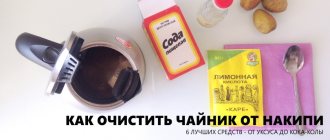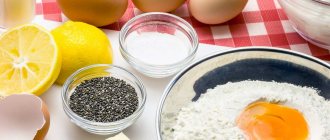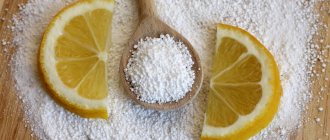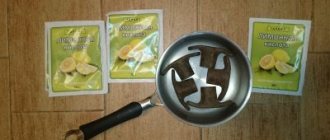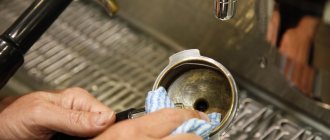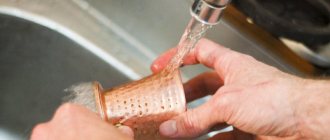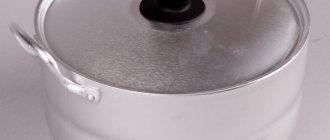Scale forms in any kettle - electric and regular. It accumulates on the walls in a thick layer, which is why the device copes worse with its main function.
Water from such a container cannot be considered clean. You can cope with the problem using inexpensive improvised means.
Read the article about how to remove scale from a kettle using citric acid using folk recipes, and how to remove lime deposits using household chemicals.
Ugly water - why scale is dangerous
The problem of severe deterioration in the quality of drinking water is acute and has been around for a long time. Various international organizations talk about this. But you don’t have to listen to them, since all this is observed even in a teapot - its cleanliness is enough for literally several cups of tea.
Of course, this is not true for everyone: if filtered or bottled water is used, then there is a chance that the housewife will not encounter a scale problem, or at least this acquaintance will not pass so quickly.
There are different types of scale, and you can judge the composition of the water by its color.
| Milky white | Excess magnesium and calcium |
| Bright white | Excess chlorine |
| Yellowish-red | Excess iron |
It would be fine if scale only caused aesthetic inconvenience. But no, it affects both the teapot and even human health.
Scale is a very hard material that consists of frozen mineral salts. It seems to wrap a shell around the walls of the kettle, which is why they heat up more slowly, and therefore boil the water more slowly. This leads to an increase in electricity bills and, sometimes, even equipment breakdown. So, keeping scale in a kettle is not an economically profitable activity.
Electricity is electricity, but health is still more expensive. But scale also affects it when it enters the body every day with tea or coffee - salts accumulate and can lead to the formation of stones or osteochondrosis.
One of the reasons why they neglect to clean the kettle is that the special chemicals are very expensive, and also contain many strange and strong substances. But experienced housewives know one secret on how to do everything quickly, cheaply, effortlessly and at home - citric acid.
Why does lemon juice work?
As mentioned earlier, scale is just a deposit of salts. Any acid makes them seem to be soluble in water, which means the hard shell is destroyed. Citric acid is the softest, cheapest and most readily available of the acids, which is why it is used for cleaning household appliances.
What is the danger?
During the use of an electrical appliance, solid deposits form on its heating element and the internal parts of the body , which occurs due to the deposition of crystals of various salts contained in water on their surfaces.
The chemical composition of insoluble scale depends on the acid-base balance and water hardness in a particular region.
Hard plaque does not have a direct negative impact on human health . Insoluble sediments have a porous structure, which is a favorable environment for the life of various bacteria and microorganisms that have a detrimental effect on the body.
ATTENTION! In addition, small particles of plaque, entering the stomach along with water, can gradually lead to disruption of the kidneys, liver and the development of urolithiasis.
Speaking about the dangers of hard water for an electrical appliance, it should be noted that the formation of scale contributes not only to the deterioration of the heating element, which is expressed in an increase in the heating time of the liquid and an increase in energy consumption: salt sediment leads to damage and deformation of the internal parts of the device body.
As a result of the formation of a significant layer of solid deposits, excessive heating of the electric kettle spiral occurs, as a result of which the household appliance may fail.
You will find 7 ways to clean an electric kettle from scale and rust in this article.
ATTENTION!
The catalyst factor for the formation of plaque on the heating element is improper care of the device: washing the kettle with metal sponges or using abrasive cleaning agents. The use of such products leads to damage to the surfaces of the housing and the spiral. Scale accumulates in the smallest scratches much faster, and it will be difficult to remove.
Do you often use an electric kettle?
Of course not
Two ways to use citric acid
If the pan is washed every time after use, then the kettle is remembered only if it has already acquired a certain amount of plaque.
It is impossible to remove scale with your hands or a sponge with dishwashing detergent, much less simply rinse. The cleaning method depends on the amount and nature of scale.
Method 1 - boiling
This method will be useful in cases where the coating is quite dense - more than 2 mm, and the heating element has a disk-shaped bottom. The procedure is as follows:
- Rinse the kettle. You can use a sponge, but it is important not to damage the inner surface of the equipment.
- Fill with water almost to the top so that it warms up as long as possible. Add citric acid. Turn on the stove or the kettle itself, if it is electric.
- During the process, you can swirl it a little to further stir the acid crystals. Return to the stove.
- After this, you need to wait one to two hours for the water to cool to about 45 degrees.
- The kettle is given a wash. If desired, you can boil it again with plain water and pour it out.
The advantage of citric acid is that even if its particles remain in the water and end up, for example, in tea, it will not cause any harm to the body.
Method 2 - soaking
This option does not involve exposure to high temperatures, therefore it is considered more gentle. But it is also less effective - it can be used only in the case of a very thin layer of plaque or as a preventive measure, for example, once a week or a month.
The principle of operation here is even simpler - fill the kettle with water, add acid and leave overnight. In the morning, it is better to turn the kettle again to further mix the solution. Rinse the kettle.
Grade
After the first and second methods, you still need to evaluate how well the “lemon” did. Some users on the Internet advise rubbing the insides of the equipment again with a hard sponge to make sure everything comes off. But such a statement can be classified as harmful advice, since microcracks from a hard sponge (and especially a metal one) are much more dangerous than ordinary citric acid.
After the solution is drained, the kettle must be rinsed and visually assessed its condition inside. If it’s perfect, or the picture has simply improved by 90%, great, but if not, then the procedure should be repeated. Don’t be afraid to pour the lemon solution several times in a row - it won’t do any harm.
Reviews
Catherine:
My grandmother taught me how to clean a kettle from plaque with citric acid. Everything sparkled on her, despite the fact that the water was hard, and whitish stripes immediately remained everywhere in the ladle, on the walls of the tank. She did not delay the cleaning and often boiled water with acid powder. I adopted the method, it turns out cheap and effective. I use it in a plastic teapot and take a small amount of powder. I boil it and then wipe it with a cloth.
Ivan:
A good way to clean a kettle, or any other utensils. Eats away all the layers. If they are old, then you need to hold the solution longer or boil it again. I also pour the solution into enamel pans if the deposit is small. I haven’t encountered severe scale, I try not to let it get to that point. I usually do prophylaxis once a month, and everything is fine.
It’s easy to clean even the oldest scale if you have citric acid on hand. It is enough to make the solution in the required proportion, follow the steps consistently, and the kettle will regain its former luster and cleanliness.
How much citric acid should be added?
The advice of experienced housewives also varies on how many spoons to add - from half a teaspoon to two tablespoons. First you need to understand what the lemon will be used for. For example:
- if only for the sake of prevention, then half a teaspoon of acid is really enough;
- if the plaque has already formed, but is very thin, then add about 10 grams of citric acid per liter of water;
- if the plaque is already substantial, the dosage can be increased, but preferably no more than 20 grams per liter.
Electric kettle
The procedure for cleaning an electric kettle itself is no different from cleaning a traditional one - you can boil it with citric acid, or you can soak it.
But it is better to use a less concentrated solution, since el. teapots are not solid equipment, but have gaskets that can deteriorate under the influence of acid. At least that's what electronics sellers advise.
However, experimentally, users have found that even after an 80-gram sachet in one kettle for one and a half liters of water, nothing bad happens, but the internal surfaces sparkle with cleanliness.
What can replace citric acid?
There are other lemon-based remedies that will help overcome nasty scale:
- a ready-made liquid solution of citric acid - it is effective, but it is expensive, and besides, it is difficult to choose the right dosage;
- real lemons - in terms of money, this method is also very expensive, since you need to fill the kettle 2/3 full with sliced lemon slices, and then add water and boil. Not only is it expensive, but it is also ineffective.
It turns out that regular lemon powder is the best option for descaling a kettle.
If you don’t want to mess with lemon and its acid at all, then there are a few more original ideas on how to clean the kettle using improvised means:
- vinegar can be called a lifesaver for an experienced housewife - it can also get rid of scale. But it cannot be used for electric kettles - only for traditional ones. It is necessary to mix vinegar with water in a ratio of 1:10 and bring the solution to a boil. After another half hour, you need to cool it, then rinse the kettle. If it is not made of metal (but, for example, covered with enamel), then it is better to reduce the concentration. It is important to use vinegar, and not 70% vinegar essence;
- soda _ This option is even simpler than the previous one. You need to add 1-2 tablespoons of soda to the kettle, let it sit for half an hour, and then bring to a boil and cool. Next, the kettle is thoroughly washed and brought to a boil, this time with clean water, which must be drained again. This option is also most often used for enamel and stainless steel. It will also be harmless to glass, but microcracks may remain on the plastic, so it is better to look for another cleaning method;
- potato or apple peelings . If there is very little scale, and there are potato peelings lying around that you would hate to throw away, then you can put them to use. All you have to do is put them in a kettle, add water and wait until it boils. After this, leave the solution to settle for another half hour. Then you still have to work with a sponge and detergent, since cleaning is not the highest;
- brine _ Surprisingly, there is also a way to descale a kettle - using brine from cucumbers or tomatoes. Of course, homemade preparations are valued, not store-bought ones. The procedure is extremely simple - pour the brine into a kettle and boil. Leave for two hours and rinse. The downside is the formation of an unpleasant odor, so it is better to immediately boil clean water and pour it out. The efficiency is higher than that of potato peelings, but you still have to work with a sponge;
- soda . Most people have probably heard that you can replace almost all household chemicals with the famous Coca-Cola. It’s difficult to say about all household chemicals, but it’s suitable for descaling a kettle. Why? Because it contains a lot of orthophosphoric acid, which, like citric acid, is considered quite weak - after all, people calmly drink cola. The acid, in turn, destroys salt deposits. The principle of operation is simple - pour in, leave the lid open (to let the gas escape), boil after two hours, and rinse the kettle. Moreover, it is better to use not the usual Coca-Cola, but something transparent so that there are no stains left on the kettle.
Alternative remedies
Citric acid is not the only means to combat scale. You can cope with it with the help of other substances that can be found in every home. Another option is to purchase a special detergent composition in the store.
The best folk recipes (with proportions)
The following substances effectively remove lime deposits in a kettle:
Sprite. This carbonated drink helps to quickly deal with plaque, without harm to the device itself.
The drink is poured into a kettle and left open for 20 minutes to allow the gas to escape, after which the liquid is brought to a boil and poured into the sink. It is not recommended to use Coca-Cola or Fanta, as they can stain the plastic kettle.- Soda and vinegar . They are used in turn. First, the kettle is boiled with a soda solution (20 g per 1 l). After which it is drained and vinegar solution is poured in (5 tablespoons per 5 liters of water). This recipe helps to cope with even the most stubborn scale.
- Oxalic acid . It is poured into the device at the rate of 10 g per 2 liters of water. The solution is brought to a boil, allowed to cool, and then poured into the sink.
How to clean using household chemicals?
You can deal with plaque using specialized household chemicals. The most effective formulations include:
- Topper for descaling a kettle. Pour 1 liter of water into the kettle and add 100-120 ml of cleaning product. Heat the water to 50 degrees and leave for half an hour. The solution is poured, rinsed thoroughly and the container is boiled. Cost 250 ml – 145 rubles.
- Mellerud. Dilute 60 ml of cleaning product in 250 ml of water, pour into a kettle, bring to a boil and turn off. After 15 minutes, the liquid is drained. The cost of 500 ml of solution is 270 rubles.
- Cinderella "Antinakipin" . Pour 2 liters of water into the kettle, pour the contents of 1 sachet into it and boil for 30 minutes. Then leave the product to act for 3 hours, drain the composition, and wash the dishes themselves with clean water. The cost of a 100 g bag of powder is 30 rubles.
Heavy artillery
In addition to pure citric acid, the kettle can be cleaned with homemade products based on it. They are very effective - they will help where one lemon could not remove scale.
- First you need to take equal parts of soda and citric acid and dilute them with water to a paste. Apply the resulting mixture to difficult areas and wait overnight. After that, pour water and boil, rinse the kettle and enjoy the cleanliness.
- This method cannot be used in electric kettles because it contains vinegar. You need to add 3-4 tablespoons of vinegar and 2-3 tablespoons of acid to a glass of water. Pour into the kettle and wait half an hour, after which you need to boil it twice, the second time with clean water.
The same products will help if rust has formed inside the kettle.
How to remove scale without heating
To descale the kettle without heating, you will need cold water and 2 packs of citric acid:
- Fill the container with water.
- Add the granules and mix thoroughly until completely dissolved.
- Leave for at least 5 hours.
- Rinse.
This gentle method can be used to clean any type of electric kettle, including one with an open heating element.
Citric acid is a safe home method for descaling a kettle. Even if a small part of the product remains on the inner surface of the housing and gets into food, there is no danger to health.
What teapots can be washed with lemon?
Nowadays you can find completely different models of teapots on the market. Even in the same house, a traditional kettle with an electric one, as well as a thermopot, can easily exist. But everyone needs to be cared for differently, because some materials can deteriorate when interacting with citric acid.
| Enameled | Citric and other acids are prohibited as they can cause thinning of the topcoat. For cleaning, it is better to use soda or peel potatoes and apples. |
| Plastic | Many sources say that acid is undesirable for plastic. But experiments show that nothing happens to him. For the first time, it is better to prepare a weak solution of citric acid and clean the kettle by soaking rather than boiling. It is better to avoid vinegar immediately. But soda, as always, will help out. |
| Metal | To clean such specimens, anything will do, unless we are talking about aluminum - it is very sensitive to acids. By the way, the most common teapots are made of stainless steel. Vinegar, soda and citric acid - you can use any product. But you should avoid abrasives and hard brushes. |
| Glass | Here, the acid will not only clean, but also add an external shine, namely, add shine to the surface. But hard sponges, brushes and abrasives should again be avoided. |
| Thermopot | In this case, citric acid is best because it is more effective than soda and does not have an unpleasant odor like vinegar. Pour a bag of lemon juice into a thermopot, boil water, leave for two hours, pour out, then wipe the surfaces with a soft cloth. |
Features for different surfaces
Different materials react differently to cleaning. In order not to spoil the dishes, you need to consider the following points:
glass - it is not afraid of contact with citric acid, but it cannot be rubbed with a wire brush, as small scratches will appear on the surface;- plastic - the device reacts normally to treatment with lemon juice, but aggressive acids should not be used to clean it;
- metal - the material is resistant to citric acid, it can be rubbed with soft brushes, but you should not try to remove scale with a knife or other sharp object.
How to clean the outside of a kettle?
The kettle is often covered with greasy droplets that fly from the stove, and then become overgrown with dust. This problem can also be easily overcome with lemon juice. There are again two options:
- if the contamination is minor, then you can simply cut off a slice of citrus fruit and rub the surface of the kettle with it, then leave the juice for half an hour, and then wash it with regular dishwashing detergent;
- if the fat is already old, then it is better to prepare a special bath with citric acid for the kettle. You must understand that the greater the amount of lemon juice, or the higher the temperature of the water, the more active the cleansing process will be.
If the stains are too complex, then the paste from the previous section will definitely handle them.
Why descale
The appearance of scale cannot be ignored. It needs to be removed. And the sooner the housewife decides to clean the kettle, the easier and better it will be for the health of the household.
Scale promotes the appearance and proliferation of bacteria. It reduces the service life of the device, in particular electric ones, and leads to its rapid failure. In addition, the chemical compounds contained in scale penetrate into the body with water. Excessive amounts of them can lead to a number of unpleasant consequences. First, the negative impact is reflected on the teeth, and then on the functioning of some organs and systems (osteochondrosis, gout, and urolithiasis develop).
Salty coating
With a one-time consumption of water from a kettle with scale, no pathological symptoms will arise. But you need to understand that salts tend to accumulate. And with regular consumption of such water, the body’s condition will begin to deteriorate.
Pros and cons of cleaning with citric acid
| Advantages | Flaws |
| Gentle cleansing process | Individual intolerance |
| Cleans up the first time | Not suitable for all materials |
| It’s safe, because citric acid is even eaten | |
| Affordable option | |
| Cleaning the kettle to new condition | |
| Removes even ancient and thick plaque |
The main thing is not to forget about rubber gloves when working with acid. In this case, the work will definitely end in success.
Cleaning the washing machine
Systematic cleaning of the washing machine with citric acid will save you from rapid aging of equipment and rapid breakdown. Hard water, which is used when washing clothes, after some time leaves a large amount of salts that settle on the heating element and other important parts of the mechanism. Multilayer scale begins to wear out the machine and the washing process becomes ineffective.
Cleaning steps
To descale your washing machine with citric acid, take the powder itself and a small piece of dry and clean cloth. The process occurs in stages:
- check the drum for the absence of things in it, since citric acid can discolor the fabric by dissolving the paint;
- a machine with a washing capacity of up to 7-8 kg requires 90-100 g of powder, for smaller equipment (up to 4 kg) 50-60 g is enough;
- It is better to pour the monohydrate into the drum and into the powder tray;
- choose the longest possible mode with all the main processes - soaking, spinning, rinsing at a temperature of no more than 60°C;
- at the end of the washing process, check the condition of the drum cuff, where dirt and sediment may be found in the flap, which is wiped with a clean cloth;
- You should then clean the drain filter from any remaining large pieces of scale and dry the powder container.
It is permissible to clean the washing machine with citric acid up to 3 times a year with high water hardness. Softer water does not have such a devastating effect on the machine, so cleaning the washing machine with citric acid in this case is allowed about 2 times a year. The preventive measure is carried out after every 30th wash.
Advantages and Disadvantages of Acid Cleaning
To clean your washing machine with citric acid, buy this common and inexpensive product in any store. Its availability for every budget is a big plus. The beneficial components of the monohydrate act quickly and effectively, which is why it is chosen to combat the most difficult contaminants, which are scale of water salts on the heating element of a washing machine.
Citric acid for the washing machine acts as a conditioner. Deposits on the rubber part of the drum often acquire an unpleasant odor due to the proliferation of bacteria and harmful microorganisms in this place. The substances contained in lemon disinfect the drum cuff and give the entire inside of the machine a pleasant citrus aroma. The used citric acid is harmless to the body. After cleaning, use the washing machine without harming the laundry.
Acid disinfects the machine drum
Citric acid does not cause harm if used in certain doses and at a clearly designated temperature. It is possible to descale the washing machine with citric acid using hot water that does not exceed 60°C. A temperature regime that almost reaches a boil (90°C) together with a large amount of substance often leads to deformation of plastic and rubber parts of the mechanism, since the solution turns out to be caustic and aggressive. Cleaning a washing machine with citric acid in such conditions means dooming it to rapid breakdown.
Preventing problems
Although most often, cleaning a kettle with citric acid is a very simple process, it is better not to bring dishes or equipment to a critical state, because, as mentioned above, this can harm your health.
There are 4 steps to help keep your kettle clean for as long as possible:
- Use clean water, such as filtered or bottled. If this is not possible, then it is better to let the tap water settle before boiling.
- Do not boil the same water several times as this will increase the chance of scale formation.
- The kettle must be washed after each use. If the water is hard, it is unacceptable to leave it after boiling.
- Once a day, or better yet, after each use, wipe dry.
And one more important rule - water is poured in first, and then the “reagent” is added. This is due to the fact that pure citric acid can be aggressive, for example, for plastic, so it is necessary to pour a diluted solution immediately.
You can watch this simple process in more detail on how to remove scale using citric acid and other means in the video.
How to remove scale from a kettle? Let's check folk methods of dealing with scale!
Tips and tricks
For cooking and drinking, it is advisable to use water purified from hardness salts. You can obtain such a liquid at home using several methods:
- by using a special filter container - they are a reservoir for collecting purified water, divided into two parts by a filter cartridge. This device is easy to use and does not require connection to a water supply;
- use of membrane filters. There are models of devices that purify water not only from salt compounds, but also precipitate organic molecules, viruses and bacteria.
When using the electric kettle, follow the rules
:
- Clean the device at least once a month;
- Try to fill the device only with purified (bottled or home-filtered) water.
